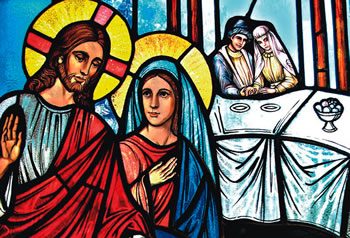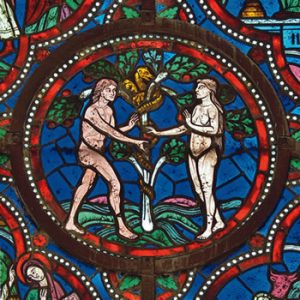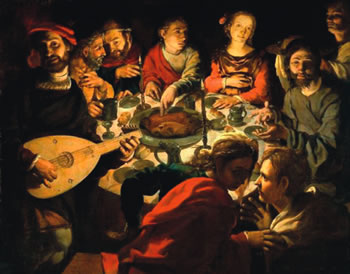Mary for Today – Mary and Jesus at the Wedding Feast at Cana
Reading John 2:1-12
Where it all began: So often we approach passages in the Scriptures with the question ‘What happened?’ rather than the richer and more revealing question ‘What does it mean?’ The most puzzling line from the Cana account concerns a line spoken by Jesus and literally interpreted from the Greek as “Woman, what have I to do with you?” The interpretation has generally gone along as some lack of understanding on Mary’s part about the nature of Jesus’ mission and of her relationship to him. It is seen as a harsh rebuke or even as a severance of the mother/son relationship at the outset of his public ministry. To read the description of the wedding at Cana in this light does suggest something problematic in the relationship between Mary and her Son.
However, if we reverse the roles, acknowledging the cultural probability that Mary was related to one of the married couple (it is highly improbable and inappropriate that she would have involved herself in the crisis otherwise) then she has a position of authority and Jesus himself is the one whom she brings to understand the significance of the moment. The passage then takes on new meaning. This gospel uses the term ‘sign’ for the great works of Jesus and signs call for understanding of their meaning, otherwise they remain unread.
Birth into his Messianic role: There is no birth narrative in John; we have to go to Matthew and Luke for that part of the gospel story of Jesus’ human origins. But at the beginning of John’s account of the public ministry of Jesus this gospel tells a story of an encounter between Mother and Son that constitutes a birthing process as Mary pushes her Son into a role that as yet he seems not ready to assume. The image of birth is not commonly ascribed to the Cana account but if two other gospels at their beginning describe the birth of Jesus into his humanity then this one describes the birth of Jesus into his public role of Jesus the Messiah/Christ.
Two women writers (Ivonne Gebara and Clara Bingemer) in their book, Mary, Mother of God, Mother of the Poor, say of this passage: “Mary’s faith begets and gives birth to the faith of the new messianic community.” So Mary becomes, in a modern insight, Mother of the Church as well as Mother of the Messiah and his mission. This is a very good indication that women scholars can bring new insights to our understanding and appreciation of the riches of Scripture.
A critical moment: Mary knew, with an intuition born of years of prayer and nearness to God, that the moment had come for a step into the unknown. Just as once she had pushed her child from the nurturing process of her own body into a hostile world, so now she was being asked to push him into the public domain, away from the private world that she had shared with him for thirty years. With typical generosity and no small sorrow, she had to break the maternal bond and surrender her Son to the world. She had to give him his freedom in order that he might win ours by becoming fully what God intended him to be.
Jesus was initially reluctant to embark upon his new path that would take him to his ‘hour’. It meant leaving the old ways of living. Mary’s own motherly concern would have cried out against what she was doing. They could avoid involvement, enjoy the wedding and go home together afterwards. As at the Annunciation, that great moment of decision in which ‘the Word became flesh,’ Mary held the divinity of Christ in her hands. She had to make the final decision on behalf of the human race. God’s gift to humanity, hidden for thirty years from public gaze, had now to be revealed. As God had waited for Mary’s “Yes,” so now God waited again. It was Mary who must utter the word that would allow God’s will to be played out in history through the saving work of her Son, Jesus Messiah.
Reading the signs of the times: Perhaps Jesus had an intuition as to the significance of the moment and far from rebuking her he was challenging her to be open to the future. He was asking if she was willing to redefine her role in relation to him, to become his disciple and mother of the Christ role he was to set out on. His words to her were heavy with heartache and promise for both of them. He knew and she knew what their relationship had been, the tenderness and love, the intimacy and togetherness in their experience of God. Now the wilderness lay ahead and a mission path stretched out that depended on Mary’s co-operation and a second “Yes.” She must go with him to the cross and beyond, in order for the Church to be born of her.
Mary accepted Jesus’ challenge, and she did so, not by responding directly to him but by turning away from him and speaking to those who were present. “Do whatever he tells you,” she told the servants, a distant echo of her words to the angel in Luke: “Let what you have said be done to me.” When humanity hears and obeys God’s Word, God’s presence is revealed. Jesus knew, from the way his mother spoke, that his hour had indeed begun. Where once she had birthed him in water and blood, now she birthed him again in water and wine – in Jewish thought, ‘the blood of the grape’. This will reach its conclusion in the blood and water that flows from the pierced side of Christ when the Woman, the Mother, will again be there.
A continuing story: From earliest times the use of the word ‘woman’ has been associated with Eve. This gospel will use the term for the Samaritan woman at the well (Jn 4:21) and also for Mary Magdalene (20:13), and finally for Mary, the woman at the foot of the cross. The many roles that women play in the gospel of John are associated with worship, resurrection and redemption. It is a woman who created the circumstances for Jesus’ revelation of his glory that ‘his disciples might believe in him’. It is a woman to whom Jesus first revealed himself as Messiah. It is to a woman that the risen Jesus first appeared: “Woman why are you weeping?”
“Woman” is a redeeming word that resounds through all of history from Eve to our present pope who calls for a more maternal and compassionate face to the church. It is no accident that the Hebrew word for mercy or compassion is rahamim and the word for womb is rahmah. To say that God is merciful is to restate the Genesis truth that ‘in the image of God male and female were created,’ and affirm one of the strongest feminine images for God.
Depthing the Meaning: The world that Jesus entered stood desperately in need of a new divine intervention. Its resources were limited: six jars, incomplete number (not the fullness of seven) and water were not adequate to meet the needs of the hour. In reality the whole mission of Jesus was to take our incompleteness and turn it into fullness. Cana is not just one moment; it is the journey of Jesus’ life to that hour when again blood and water flowed, the Woman stood at the foot of the cross with the Beloved Disciple/s who believe and take that Woman as their Mother.
And in the background to it all is the marriage feast, the goal of human life when we will all sit down at the marriage feast of the Lamb at the end time, the marriage between the Spirit and the Bride, between the Woman and the Man, the marriage of heaven and earth, the great vision at the end of the Book of Revelation.
Source: Tina Beattie (1995) Rediscovering Mary: Insights from the Gospels. Triumph Books: Missouri.




 Entries(RSS)
Entries(RSS)